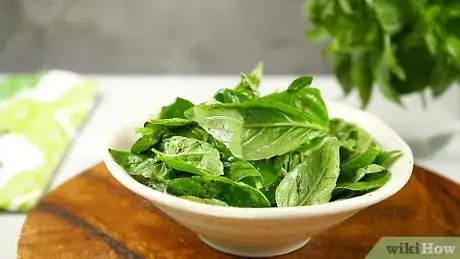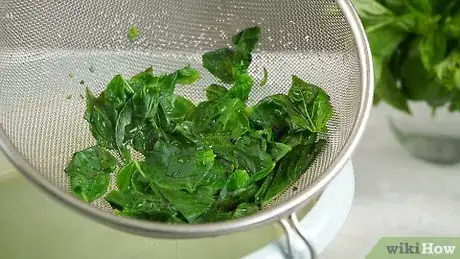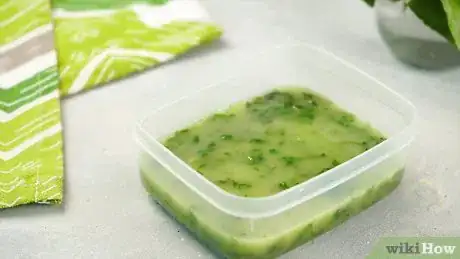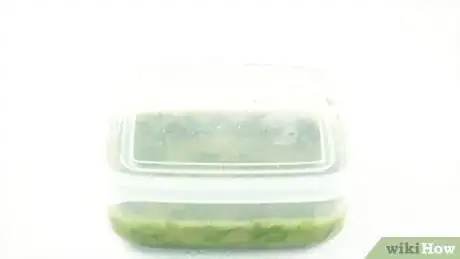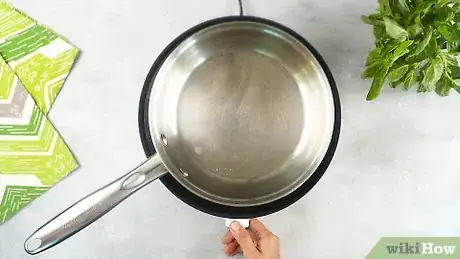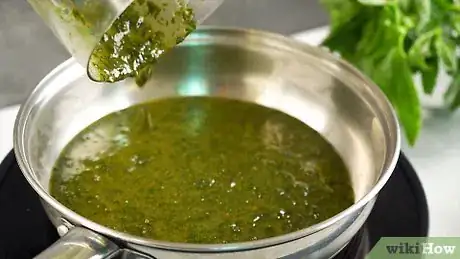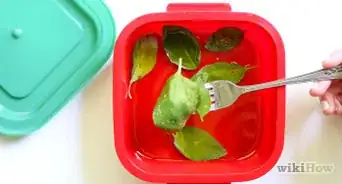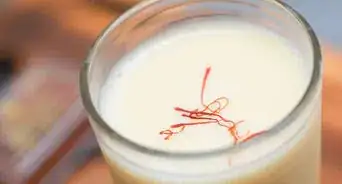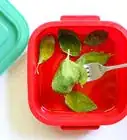This article was co-authored by wikiHow staff writer, Amber Crain. Amber Crain has been a member of wikiHow’s writing staff for the last six years. She graduated from the University of Houston where she majored in Classical Studies and minored in Painting. Before coming to wikiHow, she worked in a variety of industries including marketing, education, and music journalism. She's been a radio DJ for 10+ years and currently DJs a biweekly music program on the award-winning internet radio station DKFM. Her work at wikiHow supports her lifelong passion for learning and her belief that knowledge belongs to anyone who desires to seek it.
There are 7 references cited in this article, which can be found at the bottom of the page.
The wikiHow Culinary Team also followed the article's instructions and verified that they work.
This article has been viewed 88,812 times.
Learn more...
The best time of year to make basil oil is in the summer, when basil is fresh and fragrant. Basil oil is a great addition to light dishes because it adds a fresh flavor without overpowering other flavors. Best of all, it's simple to make as long as you have some fresh basil on hand. It's important to prepare and store herb-infused oils properly, though, to avoid a particularly dangerous form of food poisoning called botulism.[1]
Ingredients
Steps
Blanched and Blended Basil Oil
-
1Pick or buy fresh basil leaves. You'll need several handfuls of basil leaves to make 1 1/2 cups (30 grams) of packed fresh leaves. You can use basil fresh from your garden, from the supermarket, or from a local farmer's market. Basil comes in many varieties and you can use any of them to make basil oil.
- Sweet basil is the most common kind of basil in the United States. It's perfect for use in Italian dishes and soups.
- Sweet Thai basil is often used in Asian cooking; it is slightly spicier with hints of licorice and cloves.
- Lemon basil has hints of lemon along with the typical sweet basil flavors.
- Purple basil types, such as dark opal basil or purple ruffles basil, are also spicier than sweet basil.
-
2Bring a pot of water to boil. Grab a medium pot and fill it about halfway with water. Place the pot over high heat and bring the water to a boil.[4]Advertisement
-
3Add 1 1/2 cups (30 grams) of fresh basil to the boiling water. You can leave the basil leaves in the water for as little as 10 seconds or for up to 60 seconds.[5] The longer you leave the basil in the water, the more limp the leaves will become. You may lose some of the flavor if you leave the basil in for too long.
- Quickly boiling fresh herbs is called blanching. Blanching helps the basil maintain its color.[6]
-
4Place the basil leaves in a strainer. Dump the pot of water into a strainer, letting the water drain off. Run the leaves under cold water to stop the cooking process. Dump the leaves on a paper towel to dry.[7]
-
5Pat the basil dry. Use paper towels and dab at the basil gently to absorb excess water. Do not squeeze or press the basil because you'll release too much of the flavor into the paper towels.[8]
-
6Add the basil and oil to a blender. Dump the leaves into a blender or food processor. Also add in the 3/4 cup (177 ml) of olive oil.[9]
-
7Blend the mixture until it's smooth. Set the blender or food processor to puree, and blend the mixture until the leaves are smoothly incorporated into the oil.[10]
-
8Transfer the oil to a sanitized airtight container. If you won't be able to eat all of the oil immediately, put the leftovers in an airtight container. To prevent botulism, it's a good idea to sanitize your container and lid first. All you have to do is boil the container and lid in a pot of water for 10 minutes to kill any bacteria.[11]
-
9Store the oil in the fridge and use it within 2-4 days. If you don't use the basil oil immediately, keep it in the refrigerator in an airtight container and throw it out after 4 days. If you store the oil for longer than 4 days, a harmful bacteria may begin growing inside of it. This bacteria can lead to a potentially fatal form of food poisoning called botulism.[12]
- To prevent botulism poisoning, never store your oil at room temperature.
Blended and Heated Basil Oil
-
1Choose a fresh bunch of basil. Look for bright, green leaves without brown spots. You can purchase your basil or pick it from your garden. Remove the leaves from the stems, discarding the stems.[13]
- This method tends to bring out a stronger flavor in the oil, as the basil is cooked in the oil rather than in the water.
-
2Add the basil and oil to a blender. In a blender or food processor, pour in 1 cup (236 ml) of oil, and add the bunch of basil leaves. Blend the mixture until you have made it smooth.[14]
-
3Heat a small skillet. Place a small skillet on the stove, and turn it to medium to medium-high heat.[15]
-
4
-
5Strain the oil into an airtight container. Place a fine mesh strainer over an airtight container with its lid off. Pour the oil through the strainer. Don't push on the pulp, as it can make it fall through the strainer. Gently shake or tap the strainer to help the oil through.[18]
- To prevent botulism, sanitize your airtight containers and lids first. Sanitizing is easy! Put the containers and lids in a pot of water and boil them for 10 minutes to kill any bacteria.[19]
-
6Store the oil in the fridge and use it in 2-4 days. Place the oil in the refrigerator immediately to keep it fresh. Harmful bacteria may begin growing in herb-infused oil after 2-4 days, even if it's properly stored in the fridge. It's crucial that you throw out your oil after a few days to prevent the risk of botulism.[20]
- Never store herb-infused oils at room temperature! This could lead to botulism poisoning which can be fatal.
Using Basil Olive Oil
-
1Top toast with it. Cut up fresh French bread into slices. Toast it in the oven or on the grill, and then drizzle the basil olive oil over it.[21]
-
2Create stacked caprese salad. Layer tomato slices and fresh mozzarella slices together. Drizzle the oil over the top and a light sprinkling of salt for a simple caprese salad.[22]
-
3Make it a soup topping. Whether your eating tomato soup, gazpacho, or Italian wedding soup, basil oil makes a delicious topping for any Italian-themed soup. Just drizzle a little on top right before serving.[23]
-
4Try it on an open-faced sandwich. Make a traditional open-face breakfast sandwich with bacon and eggs. Pour a little oil over the top for added flavor. It also works well with other sandwiches, such as turkey and gouda.[24]
-
5Toss with vegetables. Steam your vegetables as usual. Pour in a little basil oil, and toss the vegetables until the oil coats them. Sprinkle salt over the top.[25]
Warnings
- To prevent botulism, never store your basil oil at room temperature. Keep your basil oil in the fridge at all times.⧼thumbs_response⧽
- Throw out your basil oil after 2-4 days. It's not safe to consume the oil after that since harmful bacteria may begin to grow.[26]⧼thumbs_response⧽
References
- ↑ https://www.extension.uidaho.edu/publishing/pdf/PNW/PNW664.pdf
- ↑ http://www.epicurious.com/recipes/food/views/basil-oil-5711
- ↑ http://www.foodnetwork.com/recipes/michael-chiarello/basil-oil-and-cinnamon-oil-recipe.html
- ↑ http://www.epicurious.com/recipes/food/views/basil-oil-5711
- ↑ http://www.epicurious.com/recipes/food/views/basil-oil-5711
- ↑ https://www.thekitchn.com/does-blanching-the-basil-really-make-pesto-greener-tip-test-205275
- ↑ http://www.epicurious.com/recipes/food/views/basil-oil-5711
- ↑ http://www.epicurious.com/recipes/food/views/basil-oil-5711
- ↑ http://www.epicurious.com/recipes/food/views/basil-oil-5711
- ↑ http://www.epicurious.com/recipes/food/views/basil-oil-5711
- ↑ https://www.aboutoliveoil.org/read-this-before-making-homemade-infused-olive-oil
- ↑ https://www.extension.uidaho.edu/publishing/pdf/PNW/PNW664.pdf
- ↑ http://www.foodnetwork.com/recipes/michael-chiarello/basil-oil-and-cinnamon-oil-recipe.html
- ↑ http://www.foodnetwork.com/recipes/michael-chiarello/basil-oil-and-cinnamon-oil-recipe.html
- ↑ http://www.foodnetwork.com/recipes/michael-chiarello/basil-oil-and-cinnamon-oil-recipe.html
- ↑ http://www.foodnetwork.com/recipes/michael-chiarello/basil-oil-and-cinnamon-oil-recipe.html
- ↑ http://www.foodnetwork.com/recipes/michael-chiarello/basil-oil-and-cinnamon-oil-recipe.html
- ↑ http://www.foodnetwork.com/recipes/michael-chiarello/basil-oil-and-cinnamon-oil-recipe.html
- ↑ https://www.aboutoliveoil.org/read-this-before-making-homemade-infused-olive-oil
- ↑ https://www.extension.uidaho.edu/publishing/pdf/PNW/PNW664.pdf
- ↑ http://www.finecooking.com/recipes/basil-oil.aspx
- ↑ http://www.prouditaliancook.com/2013/08/making-basil-oil.html
- ↑ http://www.finecooking.com/recipes/basil-oil.aspx
- ↑ http://www.prouditaliancook.com/2013/08/making-basil-oil.html
- ↑ http://www.finecooking.com/recipes/basil-oil.aspx
- ↑ https://www.extension.uidaho.edu/publishing/pdf/PNW/PNW664.pdf
About This Article
To make an infused oil with fresh basil, boil 1 and 1/2 cups of basil leaves for 10-60 seconds. This will blanch the leaves and bring out their bright green color. Pour the leaves into a strainer to drain off the hot water, then rinse them with cold water immediately so they don’t continue to cook. Next, spread the leaves out on a flat surface and gently pat them dry with a paper towel. Place the leaves in a blender or food processor with 3/4 of a cup of olive oil and blend the mixture until it’s smooth. Another method is to skip blanching the leaves and blend them with the oil while they’re still raw. Then, place the oil and basil blend in a skillet and let it simmer over low heat for 3 minutes to release the flavor of the basil into the oil. Strain the mixture through a fine mesh to remove the leaf fragments. Whichever method you use, if you don’t use all the oil right away, transfer the rest to a clean, air-tight container. Store the oil in the fridge and use or dispose of it within 2-4 days. For tips on how to use your basil oil, read on!
